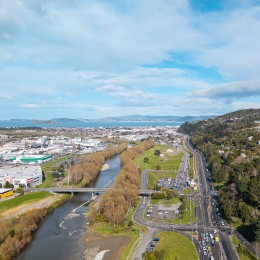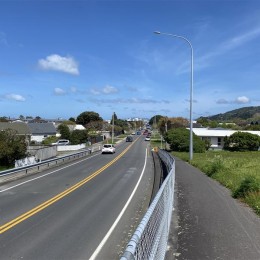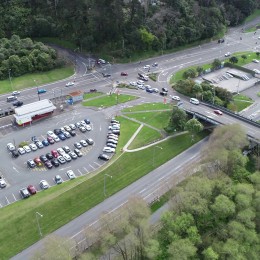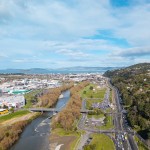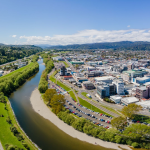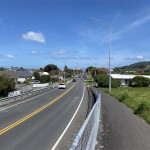Kawepūrongo
News
Te Wai Takamori o Te Awa Kairangi Community Update 20: June 2025
Newsletters, 19 June 2025Nature-based solutions to flood management
As you follow our work to strengthen the flood defences of Te Awa Kairangi / Hutt River, you might have noticed rows of uprooted trees along the river’s edge and wondered what they’re doing there.
These felled willows are part of a nature-based solution for managing erosion and flood risk. Used alongside engineered structures like rocklines and groynes, they form part of a broader bioengineering approach – one that combines vegetation with structural elements to stabilise riverbanks in a more sustainable way.
The twin goals of this bioengineering approach are to restore the health and mouri (vital essence) of the river and its surrounding environment – recognising the need to protect both the ecological and cultural values of the river – while also building resilience to flooding.
Mature willows are being harvested from both sides of the river between Melling and Kennedy Good bridges. Once felled, they are bundled, and tethered with manila rope to concrete blocks, which are buried under the river’s edge. Partially submerged, these trees remain in contact with the water, reducing water velocity and helping to prevent bank erosion as the river naturally shifts across the landscape.
Willows have been used for river management in Aotearoa since the 1840s, valued for their fast growth and robust root systems. However, the long-term goal is to transition toward native species that support a thriving indigenous ecosystem.
This shift aligns with the aspirations of our programme partners, Taranaki Whānui ki Te Upoko o Te Ika and Ngāti Toa Rangatira. Both iwi advocate for native planting – valued not only for its ecological benefits but also for its traditional and cultural significance, which contributes to the physical and spiritual wellbeing of the river. Their vision includes a river shaded and nourished by indigenous plant life, and a flourishing ecosystem rich in native fish, bird, and insects.
To support this transition, we’ve been trialling 18 native species – planted among young willows – since August 2024. Despite being tested by numerous floods during that time, the natives are holding strong. We're also trialling a range of planting supports, including wooden root pegs, wool bags, biodegradable guards, and wool mats to give these young plants the best chance of success.
Learn more about how we’re protecting Te Awa Kairangi / Hutt River
We're heading back to Marsden Street
After a short pause in demolition, you’ll soon be seeing the Greater Wellington team back on site on Marsden Street again, lifting concrete slabs and taking soil samples.
The action is happening off-road so there'll be no traffic disruption.
This prep work is paving the way for the next stage of building a new stopbank, stretching north from Ewen Bridge.
In the meantime, the team will keep the area tidy and finish off the last pieces of site preparations until construction kicks off. It’s all part of making Te Awa Kairangi / Hutt River stronger and more resilient for the community.
Demolition update in Lower Hutt
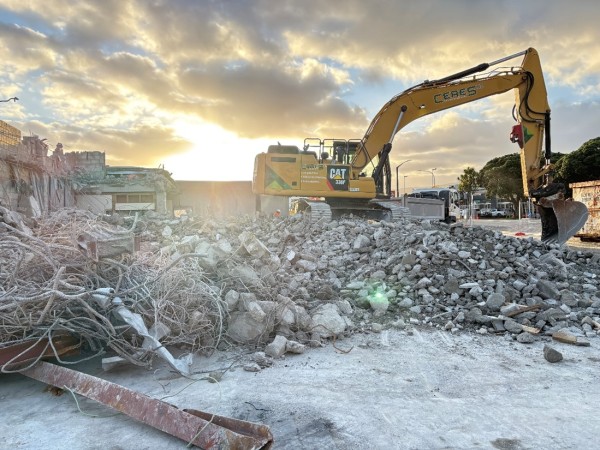
Since March, NZTA has been working to clear several key areas in Lower Hutt in preparation for construction of the new Melling interchange and bridge over Te Awa Kairangi / Hutt River.
Demolition of the old skate park on Block Road was completed in April, with the space eventually set to form part of the southbound offramp and new interchange.
Buildings on High and Rutherford streets, and Queens Drive have also been cleared. Improvements will eventually be made in this area as this will be where the new bridge over Te Awa Kairangi / Hutt River will join local roads in Lower Hutt. Work will include widening the road and changing the roundabouts at Queens Drive and Rutherford/High streets to intersections with traffic lights.
Demolition work is scheduled to be completed in July 2025. In the meantime, NZTA will continue levelling these sites, which includes some ground works around these sites, removing any deep foundations and clearing materials.
These and other parts of the programme area will remain closed off as they may be used for storage of various materials ahead of main construction which starts later this year.
This type of work is understandably disruptive at times. NZTA wants to thank nearby businesses and the community for their patience and understanding as this work progressed.
Managing disruption during construction
We’re committed to minimising the impact of construction across all parts of Te Wai Takamori o Te Awa Kairangi. But it’s important to remember that large infrastructure projects, such as this, are complex and some disruption will be inevitable.
We’re already working together, alongside local businesses, residents, and transport providers to make sure access to and from the city and state highway are maintained throughout construction.
This will continue as work begins and will include teams like Metlink and KiwiRail to carefully plan and manage how people will be able to travel around the city. We’re also looking at what paths and access we can provide for cyclists and pedestrians.
We will provide more information on upcoming disruption as construction continues.
While these disruptions may be inconvenient at times, this project will bring long-term benefits to the community. We appreciate your patience and understanding and encourage everyone to look out for one another when more construction starts later this year.
Follow us on Facebook so you'll know what’s happening and can plan accordingly.

